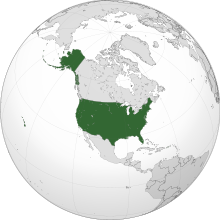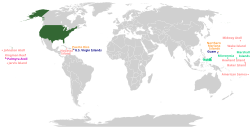The United States of America shapes global affairs as the world’s leading economic and military power. This federal republic spans 3.8 million square miles across North America, encompassing 50 states and the federal district of Washington, D.C[1].
Geographic Scope and Population
The nation stretches from the Atlantic to the Pacific, with Alaska in the northwest and Hawaii in the Pacific Ocean. The 48 contiguous states border Canada to the north and Mexico to the south. With over 334 million inhabitants, it stands as the world’s third most populous country[1].
Major Metropolitan Centers
The country’s largest urban areas showcase its demographic diversity:
- New York City: Financial and cultural hub
- Los Angeles: Entertainment and tech center
- Chicago: Industrial and transportation nexus[1]
Historical Foundation
Indigenous Heritage and Colonial Period
Native Americans first crossed the Bering land bridge over 12,000 years ago, establishing diverse civilizations. British colonization began in 1607 with Virginia, leading to the formation of the Thirteen Colonies[1].
Path to Independence
The American Revolution emerged from tensions over taxation and representation. The Second Continental Congress declared independence on July 4, 1776, establishing core values of liberty and democratic governance[1].
Modern Global Position
Economic Leadership
The U.S. maintains the world’s largest nominal GDP since 1890, representing 15% of global economic activity in 2023. The nation leads in innovation, technological advancement, and higher education[1].
International Influence
As a founding member of the United Nations, NATO, and the World Bank, the U.S. exercises significant diplomatic power. Its military presence spans 800 bases worldwide, supporting global security initiatives[1].
Political Structure
Federal System
The government operates through three branches:
- Executive: Led by the president
- Legislative: Bicameral Congress
- Judicial: Supreme Court and federal courts[1]
This system ensures checks and balances while providing substantial autonomy to individual states[1].
Cultural Impact
American values emphasize democracy, individual rights, and innovation. The nation’s cultural influence extends globally through media, technology, and educational institutions, shaping international discourse and development[1].
Citations:
https://en.wikipedia.org/wiki/United_States
The United States of America (USA), commonly known as the United States (U.S.) or America, is a country primarily located in North America. It is a federal union of 50 states and a federal capital district, Washington, D.C. The 48 contiguous states border Canada to the north and Mexico to the south, with the states of Alaska to the northwest and the archipelagic Hawaii in the Pacific Ocean. The United States also asserts sovereignty over five major island territories and various uninhabited islands. The country has the world's third-largest land area, largest exclusive economic zone, and third-largest population, exceeding 334 million. Its three largest metropolitan areas are New York, Los Angeles, and Chicago, and its three most populous states are California, Texas, and Florida.
United States of America | |
|---|---|
| Motto: "In God We Trust" Other traditional mottos:
| |
| Anthem: "The Star-Spangled Banner" | |
| Capital | Washington, D.C. 38°53′N 77°1′W / 38.883°N 77.017°W |
| Largest city | New York City 40°43′N 74°0′W / 40.717°N 74.000°W |
| Official languages | None at the federal level |
| National language | English |
| Ethnic groups (2020) | By race:
By origin:
|
| Religion (2023) |
|
| Demonym(s) | American |
| Government | Federal presidential republic |
| Joe Biden | |
| Kamala Harris | |
| Mike Johnson | |
| John Roberts | |
| Legislature | Congress |
| Senate | |
| House of Representatives | |
| Independence from Great Britain | |
| July 4, 1776 | |
| March 1, 1781 | |
| September 3, 1783 | |
| June 21, 1788 | |
| Area | |
• Total area | 3,796,742 sq mi (9,833,520 km2) (3rd) |
• Water (%) | 7.0 (2010) |
• Land area | 3,531,905 sq mi (9,147,590 km2) (3rd) |
| Population | |
• 2023 estimate | |
• 2020 census | |
• Density | 87/sq mi (33.6/km2) (185th) |
| GDP (PPP) | 2024 estimate |
• Total | |
• Per capita | |
| GDP (nominal) | 2024 estimate |
• Total | |
• Per capita | |
| Gini (2022) | medium inequality |
| HDI (2022) | very high (20th) |
| Currency | U.S. dollar ($) (USD) |
| Time zone | UTC−4 to −12, +10, +11 |
• Summer (DST) | UTC−4 to −10 |
| Date format | mm/dd/yyyy |
| Drives on | right |
| Calling code | +1 |
| ISO 3166 code | US |
| Internet TLD | .us |
Paleo-Indians migrated across the Bering land bridge more than 12,000 years ago, and formed various civilizations and societies. British colonization led to the first settlement of the Thirteen Colonies in Virginia in 1607. Clashes with the British Crown over taxation and political representation sparked the American Revolution, with the Second Continental Congress formally declaring independence on July 4, 1776. Following its victory in the 1775–1783 Revolutionary War, the country continued to expand westward across North America, resulting in the dispossession of native inhabitants. As more states were admitted, a North–South division over slavery led to the secession of the Confederate States of America, which fought states remaining in the Union in the 1861–1865 American Civil War. With the victory and preservation of the United States, slavery was abolished nationally. By 1900, the country had established itself as a great power, a status solidified after its involvement in World War I. After Japan's attack on Pearl Harbor in December 1941, the U.S. entered World War II. Its aftermath left the U.S. and the Soviet Union as the world's two superpowers and led to the Cold War, during which both countries struggled for ideological dominance and international influence. Following the Soviet Union's collapse and the end of the Cold War in 1991, the U.S. emerged as the world's sole superpower, wielding significant geopolitical influence globally.
The U.S. national government is a presidential constitutional federal republic and liberal democracy with three separate branches: legislative, executive, and judicial. It has a bicameral national legislature composed of the House of Representatives, a lower house based on population; and the Senate, an upper house based on equal representation for each state. Federalism provides substantial autonomy to the 50 states, while American values are based on a democratic political tradition that draws its inspiration from the European Enlightenment movement.
One of the world's most developed countries, the United States has had the largest nominal GDP since about 1890 and accounted for over 15% of the global economy in 2023. It possesses by far the largest amount of wealth of any country and has the highest disposable household income per capita among OECD countries. The U.S. ranks among the world's highest in economic competitiveness, productivity, innovation, human rights, and higher education. Its hard power and cultural influence have a global reach. The U.S. is a founding member of the World Bank, the Organization of American States, NATO, and the United Nations, as well as a permanent member of the UN Security Council.






